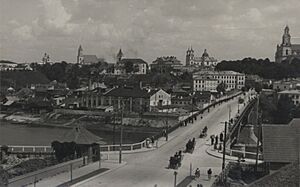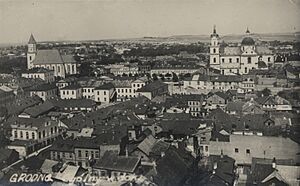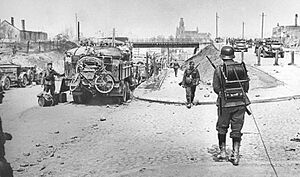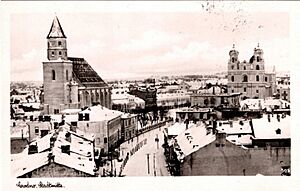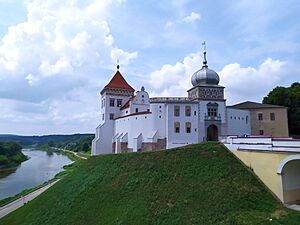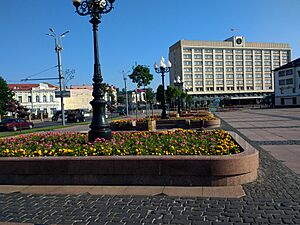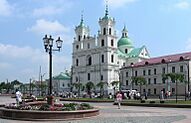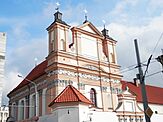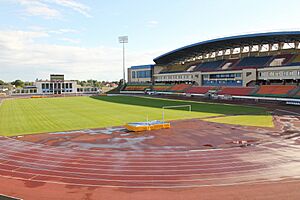Grodno facts for kids
Quick facts for kids
Grodno
Гродна • Гродно
Hrodna
|
|||
|---|---|---|---|
|
|||
| Country | Belarus | ||
| Region | Grodno Region | ||
| Founded | 1127 | ||
| Area | |||
| • Total | 142.11 km2 (54.87 sq mi) | ||
| Elevation | 137 m (449 ft) | ||
| Population
(2024)
|
|||
| • Total | 361,115 | ||
| • Density | 2,541.09/km2 (6,581.41/sq mi) | ||
| Time zone | UTC+3 (MSK) | ||
| Postal code |
230000
|
||
| Area code(s) | +375-15 | ||
| License plate | 4 | ||
| Website | Official website: http://grodno.gov.by/ | ||
Grodno (also called Hrodna) is an old and important city in western Belarus. It sits on the Neman River. The city is about 300 kilometers (186 miles) from Minsk, the capital of Belarus. It is also close to the borders with Poland (about 15 km or 9 miles) and Lithuania (about 30 km or 19 miles). Grodno is the main city of the Grodno Region. In 2024, about 361,115 people lived there.
Grodno was founded in 1127. It started as a small fort and a trading spot. It was a key city in the region known as Black Ruthenia. Later, it became part of the Grand Duchy of Lithuania. This duchy then joined with Poland to form the Polish-Lithuanian Commonwealth in 1385. Grodno was often attacked, especially by the Teutonic Knights. It became a major center for trade, business, and culture. It was also one of the royal homes for the rulers of the Commonwealth.
The city has a long and interesting history. It was part of Russia after 1795. Before World War II, many Jewish people lived here. After the wars, Grodno became part of Belarus. Today, Grodno is known for its beautiful old buildings, like the Old Grodno Castle. It is also a center for Roman Catholic and Polish culture in Belarus.
Contents
Other Names for Grodno
Grodno has been known by many names throughout history. In Belarusian, it is called Горадня (Horadnia). In Latin, it was known as Grodna. Other names include Grodno in Polish, Gardinas in Lithuanian, and גראָדנע (Grodne) in Yiddish.
History of Grodno
![]() Grand Duchy of Lithuania (1391–1569)
Grand Duchy of Lithuania (1391–1569)
![]() Polish–Lithuanian Commonwealth (1569–1795)
Polish–Lithuanian Commonwealth (1569–1795)
![]() Russian Empire (1795–1917)
Russian Empire (1795–1917)
![]() Belarusian Democratic Republic (1918–1919)
Belarusian Democratic Republic (1918–1919)
![]() Republic of Lithuania (1920)
Republic of Lithuania (1920)
![]() Republic of Poland (1919–1939)
Republic of Poland (1919–1939)
![]() Soviet Union (1939–1941)
Soviet Union (1939–1941)
![]() Nazi Germany (1941–1944)
Nazi Germany (1941–1944)
![]() Soviet Union (1944–1991)
Soviet Union (1944–1991)
![]() Belarus (1991–present)
Belarus (1991–present)
Before the East Slavs arrived around the 10th and 11th centuries, the Grodno area was home to the Yotvingians. These were a Baltic tribe. Grodno began as a small fort and trading post. It was built by Rurikid princes. The first mention of Grodno dates back to 1005.
The city's official founding year is 1128. In that year, it was called Goroden in the Kievan Chronicle. It was an important place where many trade routes crossed. The chronicle also mentions that in 1183, a lightning strike caused a big fire. The fire burned down all of Goroden, including its stone churches.
Grodno was a main city on the western edge of Black Ruthenia. This area was next to the Grand Duchy of Lithuania. It was often attacked by different groups, especially the Teutonic Knights. In the 1240s and 1250s, Lithuanian princes took control of the Grodno area. They formed the Grand Duchy of Lithuania. This duchy later joined with Poland in 1385. The famous Lithuanian Grand Duke Vytautas was the prince of Grodno from 1376 to 1392. He stayed there while preparing for the important Battle of Grunwald in 1410.
Grodno in the Polish–Lithuanian Commonwealth
To help trade grow, the grand dukes allowed Jewish people to form a community in 1389. This was one of the first Jewish communities in the Grand Duchy. In 1441, Grodno received its city charter. This charter gave the city special rights and freedoms.
Grodno became an important center for trade, business, and culture. It was a notable royal city and a home for the kings of the Polish–Lithuanian Commonwealth. The Old and New Castles were often visited by monarchs. King Stephen Báthory of Poland even made the castle his main home. Kings Casimir IV Jagiellon and Stephen Báthory both died there. Grodno was also a place where the Sejms (parliaments) were held. The very last Sejm of the Commonwealth took place in Grodno in 1793.

The city saw two battles during the Great Northern War, in 1706 and 1708. In 1793, Grodno became the capital of the Grodno Voivodeship. However, in 1795, Russia took control of the city. This happened during the Third Partition of Poland. The last Polish king, Stanisław August Poniatowski, gave up his throne in the New Castle on November 25, 1795. Grodno then became the capital of the Grodno Governorate in the Russian Empire.
Before the the Holocaust, Grodno had a large Jewish population. In 1897, almost half of the city's 46,900 people were Jewish.
World War I and Between the Wars
During World War I, Germany occupied Grodno in 1915. After the war, a short-lived state called the Belarusian People's Republic was allowed to form there. Military control stayed with Germany until April 1919.
In April 1919, Germany handed control of Grodno to Poland. The city was then taken by the Red Army in July 1920 during the Polish–Bolshevik War. The Soviet–Lithuanian Treaty of 1920 planned for Grodno to go to Lithuania. However, the Soviets lost the Battle of Warsaw. This meant Lithuania never took control. The Polish Army recaptured the city in September. After the Peace Treaty of Riga, Grodno remained part of Poland.
Grodno became a large Polish Army base in the late 1920s. This helped the local economy. It was also an important center for Jewish culture. About 37% of the city's people were Jewish, and 60% were Polish.
World War II and After
During the Invasion of Poland in 1939, Grodno's soldiers fought against the invading German army. When the Soviet invasion of Poland began in September 1939, there was heavy fighting in Grodno. The Battle of Grodno took place from September 20-22. After the Soviets took the city, many Polish defenders were killed.
The city was then occupied by the Soviet Union. It became part of the Byelorussian Soviet Socialist Republic. Thousands of Polish people living in Grodno were sent to faraway parts of the Soviet Union.
On June 23, 1941, German forces occupied Grodno. This occupation lasted until July 16, 1944. During this time, most Jewish people were forced into the Grodno Ghetto. They were later sent to extermination camps and killed. The Germans also ran a prison in the city.
Since 1945, Grodno has been a main city in the Byelorussian Soviet Socialist Republic. Today, it is part of the independent Republic of Belarus. Many Polish people moved to Poland after the war. However, in 2019, Poles were still the second-largest group in the city (22%), after Belarusians.
Much of Grodno's old town was damaged during World War II. After the war, some historical buildings were torn down. For example, the Church of the Blessed Virgin Mary, Grodno, known as Vytautas' Church, was destroyed in 1961. The old Grodno Town Hall was also demolished.
In 2005, work began to rebuild Grodno's historical center. However, some of these projects have been criticized. For example, the reconstruction of the Old Grodno Castle started in 2017. Some experts say it doesn't look exactly like the original.
Despite losing some of its old buildings, Grodno still has many historical sites. It is often called the "royal city." It is a popular place for tourists to visit. The area around Grodno and Brest has a special rule. Foreign visitors can come without a visa for up to 15 days.
Jewish Community in Grodno
Jewish people began to live in Grodno in the 14th century. This was allowed by the Lithuanian Grand Duke Vytautas. In 1495, Jews were made to leave the city, but they were allowed to return in 1503. By 1560, there were 60 Jewish families in Grodno. They lived on a "Jewish street" and had their own synagogue and "hospital." The Great Synagogue of Grodno was built in 1578.
The Jewish population grew after Grodno became part of the Russian Empire in 1795. By 1907, about 25,000 Jews lived in Grodno. This was almost half of the city's total population.
Before World War II, about 25,000 Jews lived in Grodno. During the German occupation, on November 1, 1942, Jews were forced into two ghettos. One ghetto was in the old part of the city, where the main synagogue was. A high wall was built around it. The second ghetto was in the Slovodka area. Many Jews were later sent to extermination camps like Auschwitz and Treblinka. By the end of the war, only a few hundred Jews from Grodno had survived.
After the war, the Jewish community slowly came back. Most Jews left after the Soviet Union broke apart. Today, there are a few hundred Jews in Grodno. Their activities are centered at the main synagogue, which was returned to the community in the 1990s. A special plaque remembers the 25,000 Jews who were killed in the two ghettos in Grodno. It is on a building where the ghetto entrance used to be.
Geography
Several rivers flow through Grodno. These include the Neman River, the Lasosna River, and the Haradničanka River. The Haradničanka River also has a smaller branch called the Yurysdyka River.
Religion, Education, and Culture
Grodno has one of the largest groups of Roman Catholics in Belarus. It is also a center for Polish culture. Many Poles live in the city and nearby areas.
There is also a large Eastern Orthodox population. The city's Catholic and Orthodox churches are beautiful old buildings.
Grodno is home to several universities. These include the Grodno State Medical University, the Yanka Kupala State University of Grodno, and Grodno State Agrarian University. A Polish school was built in 1995. Here, students can learn all subjects in Polish. This helps them prepare for Polish universities.
Architecture
The city was designed around the Old Grodno Castle. This castle was first built from stone by Grand Duke Vytautas. It was later rebuilt in the Renaissance style. King Stephen Báthory made it his main home. He died there in 1586. The castle has been changed many times over the years. A stone arch bridge from the 17th century still connects it to the city. The kings of Poland later built the New Grodno Castle. Its fancy Baroque rooms were destroyed during World War II.
Old Buildings

The oldest building still standing in Grodno is the Kalozha Church of Sts. Boris and Gleb. This church is the only remaining example of ancient architecture from Black Ruthenia. It is special because it uses colorful, cut stones of blue, green, or red. These stones form crosses or other shapes on the walls.
The church was built before 1183. It stayed whole until 1853, when part of its wall fell. This happened because it was built on the high bank of the Neman River. During repairs, old paintings from the 12th century were found inside.
Baroque Style Buildings
The Cathedral of St. Francis Xavier is in Soviet Square. It was a Jesuit church until 1773. This tall church, over 50 meters (164 feet) high, was started in 1678. It took 27 years to finish because of wars. Its beautiful Baroque paintings were added in 1752.
The large Bernardine monastery (built 1602–18) shows many styles from the 17th century. Its inside is considered a great example of Vilnius Baroque style. Other old religious buildings include the Franciscan cloister (1635) and the Bridgettine cloister (1642). The Bridgettine cloister has a wooden two-story building from the 1630s that is still standing.
Other interesting places in Grodno include the Orthodox cathedral, built in 1904. There is also a botanical garden, which was the first in the Polish–Lithuanian Commonwealth. It was started in 1774. You can also see the Grodno TV Tower, which is 254 meters (833 feet) tall. Stanisławów was a summer home for the last Polish king.
Transportation
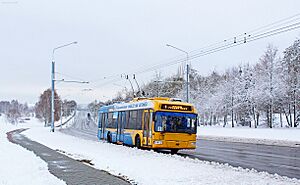
Grodno has an airport, Grodno Airport, about 18 kilometers (11 miles) southeast of the city. It has some international and charter flights at different times of the year.
The city's public transport includes trolleybuses. They started running in Grodno on November 5, 1974. The trolleybus system has 12 routes. It carries about 66.5 million passengers each year. New routes have been added, like routes 21 and 22 in 2019.
Grodno's railway station was once an important stop between Poland and Lithuania. However, the connection to Lithuania has been cut.
Sports
Grodno has several sports venues:
- Neman Stadium: This is the official stadium for CSC Nyoman, with 8,800 seats. It is home to the FC Neman Grodno football team and FHC Ritm (Grodno) hockey team.
- Grodno Ice Sports Palace: This arena has 2,539 seats. It is home to the HC Neman Grodno hockey team.
- Grodno Indoor ice rink in Pyshki.
- Sport complex "Viktoryya": This complex is home to the basketball club Grodno-93, the women's basketball club Alimpiya, the handball club Kronan, and the women's handball club Haradnichanka.
Education
Grodno has several higher education institutions:
- Yanka Kupala State University of Grodno
- Grodno State Medical University
- Grodno State Agrarian University
- Grodno Higher Theological Seminary
There are also 41 middle schools (or secondary schools) in Grodno.
Culture
Grodno has many cultural activities. There are over 220 groups, clubs, and studios in 21 city offices. About 6,500 children and adults take part in amateur performances. Many of these groups have won national or exemplary awards.
Every two years since 1996, Grodno hosts the Festival of National Cultures. This is the largest festival of its kind in Belarus. It brings many visitors to the city.
Grodno also holds various festivals, national holidays, and ceremonies every year. These include "Student's spring" and an international piano music celebration.
Visa-Free Travel to Grodno
Since October 26, 2016, people from 77 countries can visit Grodno and the Grodno District without a visa. They can stay for up to 10 days.
Notable People
Many interesting people were born in Grodno or were active there.
- Born in Grodno
- David of Grodno (died 1326): A famous military leader for Gediminas, the Grand Duke of Lithuania.
- Zygmunt Wróblewski (1845–1888): A Polish physicist and chemist.
- Meyer Lansky (1902–1983): A well-known figure in organized crime.
- Olga Korbut (born 1955): A gymnast who won four gold medals at the 1972 and 1976 Olympic Games.
- Paul Baran (1926–2011): An Internet pioneer and technology entrepreneur.
- Active in Grodno
- Vytautas the Great (1350–1430): Grand Duke of Lithuania and a commander in the Battle of Grunwald.
- Antoni Tyzenhaus (1733–1785): A local leader who started many factories in the area.
- L. L. Zamenhof (1859–1917): A Polish doctor who created the Esperanto language.
- Eliza Orzeszkowa (1841–1910): A Polish writer who lived and worked in Grodno.
- Died in Grodno
- Casimir IV Jagiellon (1427–1492): King of Poland and Grand Duke of Lithuania.
- Stephen Báthory (1533–1586): King of Poland and Grand Duke of Lithuania.
International Connections
Grodno is connected with other cities around the world. These are called "twin towns" or "sister cities."
 Ashkelon, Israel
Ashkelon, Israel Cheboksary, Russia
Cheboksary, Russia Dzerzhinsk, Russia
Dzerzhinsk, Russia Khimki, Russia
Khimki, Russia Kraljevo, Serbia
Kraljevo, Serbia Limoges, France
Limoges, France Minden, Germany
Minden, Germany Qabala District, Azerbaijan
Qabala District, Azerbaijan Rancho Cordova, United States
Rancho Cordova, United States Shchukino District (Moscow), Russia
Shchukino District (Moscow), Russia Tambov, Russia
Tambov, Russia Tuapsinsky District, Russia
Tuapsinsky District, Russia Vologda, Russia
Vologda, Russia Žilina, Slovakia
Žilina, Slovakia
Images for kids
See also
 In Spanish: Grodno para niños
In Spanish: Grodno para niños








